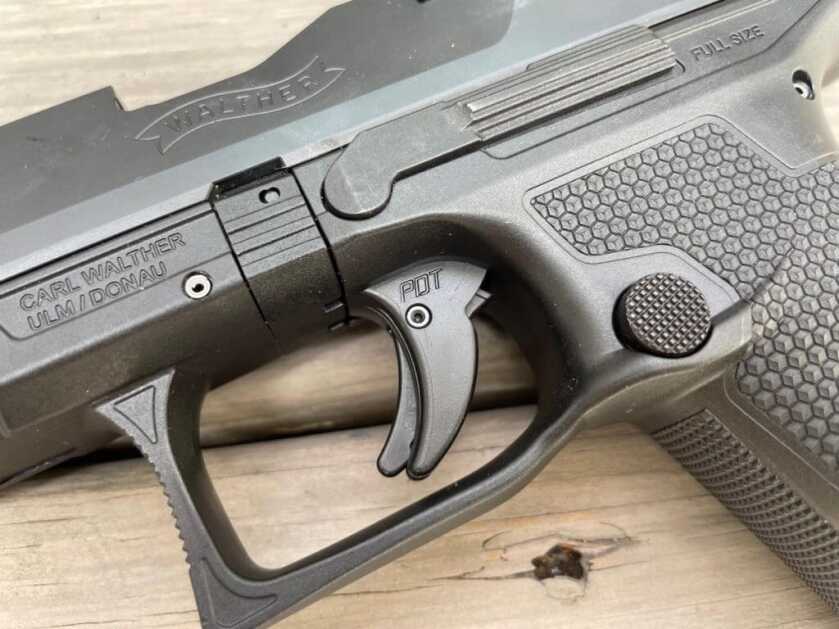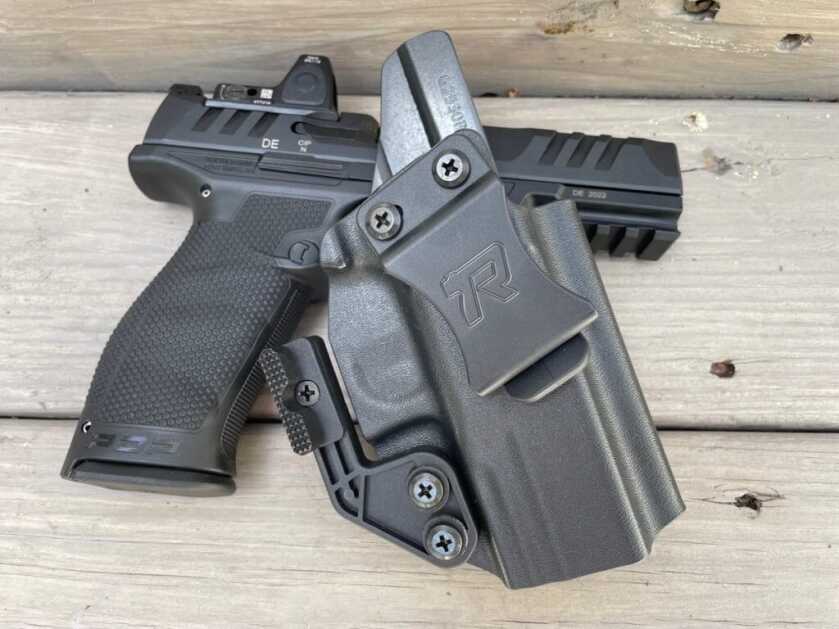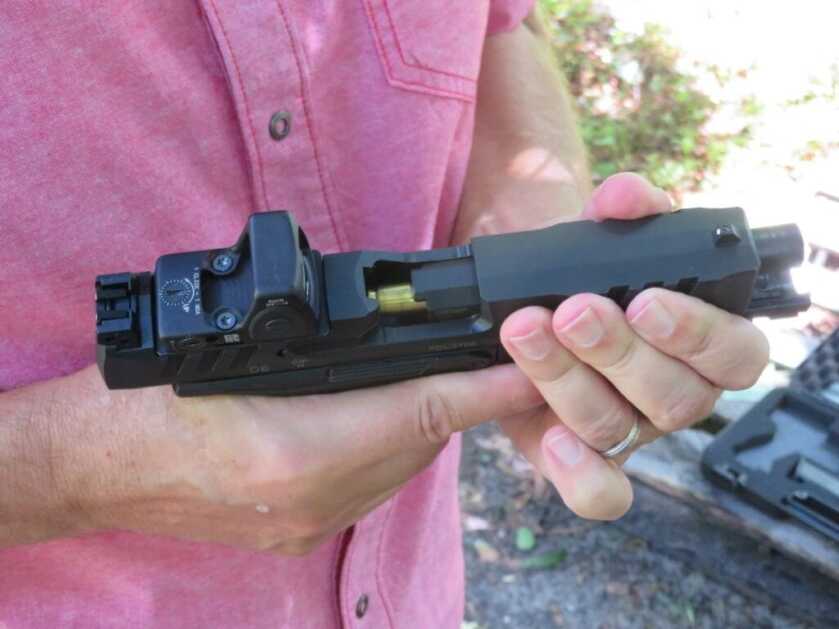Estimated reading time: 11 minutes

Walther built the PDP (Performance Duty Pistol) series to appeal to a range of shooters who want a pistol for concealed carry.
Table of contents
The thing is one size does not fit all and Walther knows this; which is why PDP pistols come with either a full-size or compact-size frame and three different barrel lengths: 4”, 4.5”, and 5”. You can get a PDP set up your way with a compact frame and either a 4” or 5” barrel or a full-size frame with a 4”, 4.5”, and 5” barrel.
The compact frame holds 15 rounds in a flush fit magazine and the full-size frame holds an 18-round flush fit magazine. I opted for a 4.5” barrel on a full-size frame; something useful for EDC yet large enough so it is easy to shoot well.
Walther PDP 4.5″
The PDP 4.5”, like all of the PD series, is a 9mm striker-fire, recoil-operated pistol with a polymer frame. Keeping with shooters’ expectations the slide is cut for an optic and it has a modular back strap. Check those two boxes. In fact, the PDP checks a lot of boxes for a 9mm striker fire. Those still to be determined include performance, reliability, accuracy, and ease of use.

The moment the PDP had my attention was when I picked it up. The grip ergonomics are sublime. The flat front grip strap and the arched back strap fit nicely between your fingers and the web of your hand, and the palm swell fills that void between the grip and your palm. Your hand feels glued to the grip. Walther calls the grip texture Performance Duty Texture which is a tetrahedron design that provides an aggressive surface but is non-abrasive. There’s no irritation to your hand even after extended range sessions and it doesn’t snag on clothing.
Grip Designed For Red Dots
The flat front grip strap is checkered and at the base is a forward sweep or lip. Walther calls this RDS Ergonomics, which I thought was marketing jargon for fancy grip. When you grip the pistol and your small finger grips that lip it causes the muzzle to dip slightly; just enough for you to pick up the dot in an optic when aiming the gun. I have to say it works. I didn’t find myself looking in the screen of the optic for a red dot. It appears as I present and push out the pistol to aim. Box checked.

Another way Walther has optimized the PDP for a red dot is the slide cut. The cut in the PDP slide is deeper than the cut on the other optic-ready pistols. This means the optic sits lower and depending on the red dot you use, you may not need to install tall, suppressor height sights. If you do need to swap sights, the PDP is compatible with Glock aftermarket sights, so you will have a lot of different options if you carry the PDP old-school style with just iron sights. The three-dot sights are nothing special, but the rear sight is completely adjustable in the event you want to run the PDP without an optic. Check and check.
Optic Plate PSA
The Walther does not ship with an optic plate like most optic-ready pistols. You need to go to Walther online and tell them what pistol you have and what red dot you will be using. Walther then ships the optic plate to you free of charge. What does come in the hard case are two magazines, a magazine reloader, and two back straps.
Performance Duty Trigger
The trigger is the next feature that’s impressive. Walther calls it a PDT or Performance Duty Trigger. You have to wade through a lot of Walther abbreviates like PDP, RDS, and PDT. The trigger is repeatable and predictable. There is a bit of take-up then you hit the wall. After that, the trigger breaks quickly and cleanly. You can easily take up the slack and it is a short press to fire the shot. The reset is short so you can follow up with a fast shot. I could tell right away that my slit times were less firing the PDP. The trigger broke at 4.6 pounds on average. It’s better than some aftermarket triggers I’ve tested. Check.

The Long, Large PDP lide
The ambidextrous slide stop is long and large. If you have a lazy shooting hand thumb you can accidentally ride the slide stop causing the slide not to lock back on the last round fired. Just point your shooting hand thumb forward not up like when you ride the thumb safety on a 1911. The magazine release button is round, big, and checkered so dumping an empty magazine is fast. The magazine button can also be swapped for a left-hand shooter.

The slide has course serrations forward and aft that Walther describes as SuperTerrain Serrations (I’m surprised Walther doesn’t have an abbreviation for this feature) that protrude from the slide rather than cut into the slide. They offer excellent grasping points when ranking the slide or doing a press check. There is a lot of metal removed from the outside of the slide. Inside metal is relieved, too. This reduces the clunk-clunk of the slide recoiling back and forth.

Trijicon RMR
I mounted my go-to red dot the Trijicon RMR Type 2 with a 3.25 MOA dot, which is a good size dot for defense work and competition shooting. Fast at close range and it does not obscure the target at longer distances. Buttons on the sides of the optic allow the user to adjust the illumination brightness, toggle between manual and automatic modes, and turn off the sight. In automatic mode, the sight automatically adjusts the brightness of the dot based on lighting conditions. In manual mode, the user can adjust dot brightness. After 16.5 hours in manual mode, the sight will default back to the automatic mode. Elevation and windage screws can be adjusted using the rim of a 9mm cartridge case and the directions are clearly marked.

The RMR is always on so when you draw the weapon the dot is on. The sight needs to be removed from the pistol when changing the battery and that is a pain. After chasing the battery it is a good idea to check the zero. There is no flaring of the dot as there can be with other red dot optics. With the RMR installed tall sights are needed. Red dots make aiming easier than aligning traditional iron sights, but finding the red dot can be a liability, especially in bright light conditions. For this as well as when the battery gives up the ghost are reasons to install co-witness iron sights.

PDP Concealed
Shooting a handgun is one test, the other is carrying it concealed carry. I used a Rounded IWB Kydex holster that’s optic-ready and has an oversized sight channel to accommodate suppressor height sights. The cant and retention can be adjusted. I also used Rounded’s Claw Kit which pushes the butt of the pistol towards your body to eliminate printing. This setup works great, especially with the full-size pistol.
SEE MORE: Walther PDP Compact: Performance & Duty are its Name

Going Hot
Different bullet weights and types were used. Training rounds consisted of Winchester White Box and Federal American Eagle, both loaded with 115-grain FMJ bullets. Defense loads included Remington HTP with 147-grain JHP bullets and SIG V-Crown with 124-grain JHPs.
At 25 yards I tested for accuracy using Thompson Targets TAC (Training with Audible Cue) targets. You can use these targets with a partner who cues the shooter on what part of the target to fire at. The idea with TAC targets is to train the shooter to process commands and make decisions quickly. Scores can be calculated so you can see how well you did and have bragging rights for the day.

I like performing the Bill Drill when trying out handguns. From a draw or low ready fire six rounds as fast as you can. Only A-zone hits count. The A-zone measures 5.9×11 inches on an official IPSC target. To change it up I use inexpensive 8-inch paper plates, too. This helps me get a feel for the slide cycle, muzzle flip, sight acquisition, grip, and trigger.

Speed
In the speed drill, there was some muzzle flip but the grip helps to manage recoil and the exceptional trigger allowed me to fire very quickly. This is a forgiving gun that allows the user to shoot better and more accurately as well as faster. I was surprised at how easily I adapted to this pistol and how well I was able to shoot it. The large magazine release is close to your thumb to dump an empty magazine fast.

I used the red dot sight as an impromptu cocking lever with my hand, the edge of a shooting bench, and the mouth of a Kydex holster. Front slide serrations are important when a red dot is mounted on these pistols since the optic gets in the way of a traditional pinch-style slide rack where your support hand palms the top of the slide and you pinch the slide between your thumb and index finger to pull back the slide.

Conclusion
There is simplicity with a striker-fire pistol like the Walther PDP. Grip, trigger, and accuracy are excellent. The PDP 4.5” is an excellent pistol. It checks all the right boxes.
*** Buy and Sell on GunsAmerica! ***


Too bad import rules mandate they use flimsy plastic sights. Are there ay good aftermarket metal sights for these?